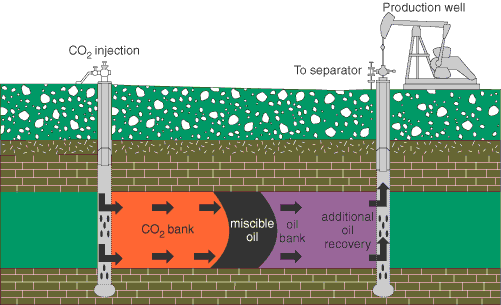| Kansas Geological Survey | Spring 1999 |
Vol. 5.2 |
|
CO2 May Bring New Life to Old Oil Fields
CONTENTS CO2 and Oil fields–page 1
|
Every day we discharge tons of
carbon dioxide (CO2), a greenhouse gas, into the
atmosphere. Researchers at the Kansas Geological Survey and the Tertiary
Oil Recovery Project (TORP) at the University of Kansas may have an alternative—pump
the CO2 underground and use it to produce more oil. Survey and TORP researchers are studying the possibility of using CO2
to recover more oil from underground reservoirs in Kansas. Over six billion
barrels of oil have been produced in Kansas, but production today is only
about one-third of what it was in the 1950’s. Most of the state’s
6,000 oil fields are near the end of their economic lives even though
they still contain considerable oil. A process called carbon dioxide miscible flooding could greatly expand
the lives of these oil fields. “This process may have the potential
to recover an additional 250 million to 1 billion barrels of oil from
Kansas reservoirs,” said Alan Byrnes, petroleum researcher at the
Kansas Geological Survey. Here’s how it works. Liquid CO2 is pumped
under high pressure into the reservoir through injection wells, creating
a CO2 flood bank. The front of this CO2
bank mixes with the trapped oil, causing it to become more mobile. As
more oil is encountered, an oil bank forms and is pushed ahead of the
CO2 flood bank toward producing wells. The producing
wells pump the oil to the surface where the CO2
is separated from the oil and reinjected back underground. Carbon dioxide miscible flooding removes up to 90 percent of the oil
contacted by the CO2 flood. Without such new technologies,
many of these fields will be abandoned with considerable oil left in the
ground. The Survey and TORP are currently evaluating the technical and economic
viability of CO2 miscible flooding in Kansas. “Although
the potential is great, the process must be proven in Kansas reservoirs
before operators will be willing to invest in a pipeline to bring CO2
to Kansas,” said Byrnes. The first phase of the project—determine the potential amount of
recoverable oil, evaluate the feasibility of CO2
flooding in Kansas, and identify potential sites for a pilot project—will
be finished this summer, with support from the Kansas Technology Enterprise
Corporation (KTEC) and matching funds from the KU Energy Research Center
(KUERC) and Shell CO2 Company, Ltd. The Survey and
TORP are working together under the KUERC umbrella. The next step is submitting a proposal to the Department of Energy (DOE)
for funding a pilot project at Hall-Gurney field in Russell County. The
demonstration project will target the Lansing-Kansas City reservoir and
involve one CO2 injection well and four to six producing
wells. Currently, there are no CO2 wells in Kansas, nor
is there a pipeline carrying CO2 into the state.
CO2 for the demonstration project at Hall-Gurney
must be trucked to the site from out of state. Researchers are also considering
collecting CO2 from the flue gases discharged at
electrical generating facilities. The CO2 that is
currently being vented to the atmosphere could be used for CO2
miscible flooding. “If we can economically capture all the CO2
from the 86 power plants in Kansas,” said Byrnes, “it could
all be used for CO2 miscible flooding, thus enhancing
the state’s oil industry and economy and sequestering a greenhouse
gas.” Using CO2 for miscible flooding of mature oil reservoirs effectively closes the fossil fuel-energy loop. Fossil fuels are burned in power plants for energy. The waste gas from combustion, the CO2, is returned underground for CO2 miscible flooding. “We are extracting the energy from underground fossil fuels,” said Byrnes. “By returning the CO2 to the subsurface, we have reduced the environmental cost of that energy.” |
|
Carbon dioxide miscible flooding. |
 |
| Online February 10, 2003 Comments to: lbrosius@kgs.ku.edu Kansas Geological Survey URL:http://www.kgs.ku.edu/Publications/GeoRecord/1999/vol5.2/Page1.html |